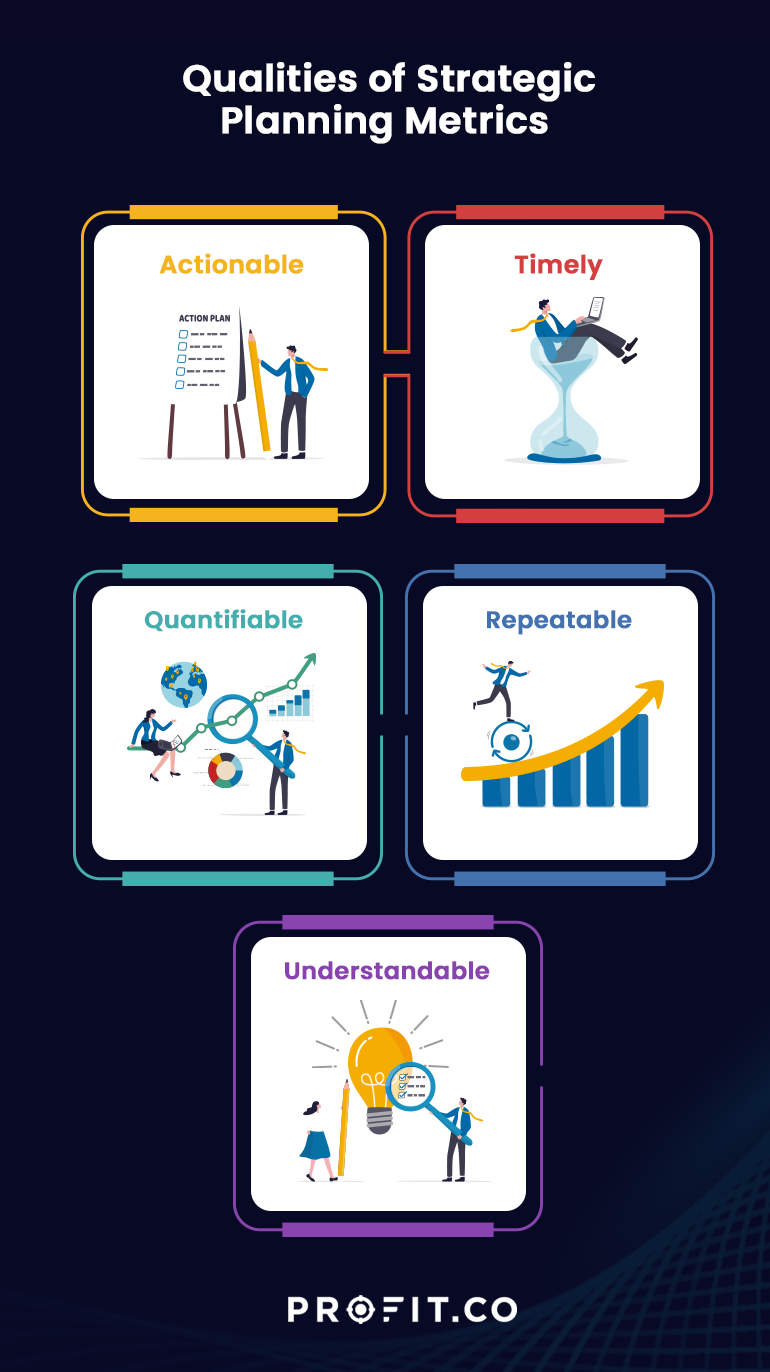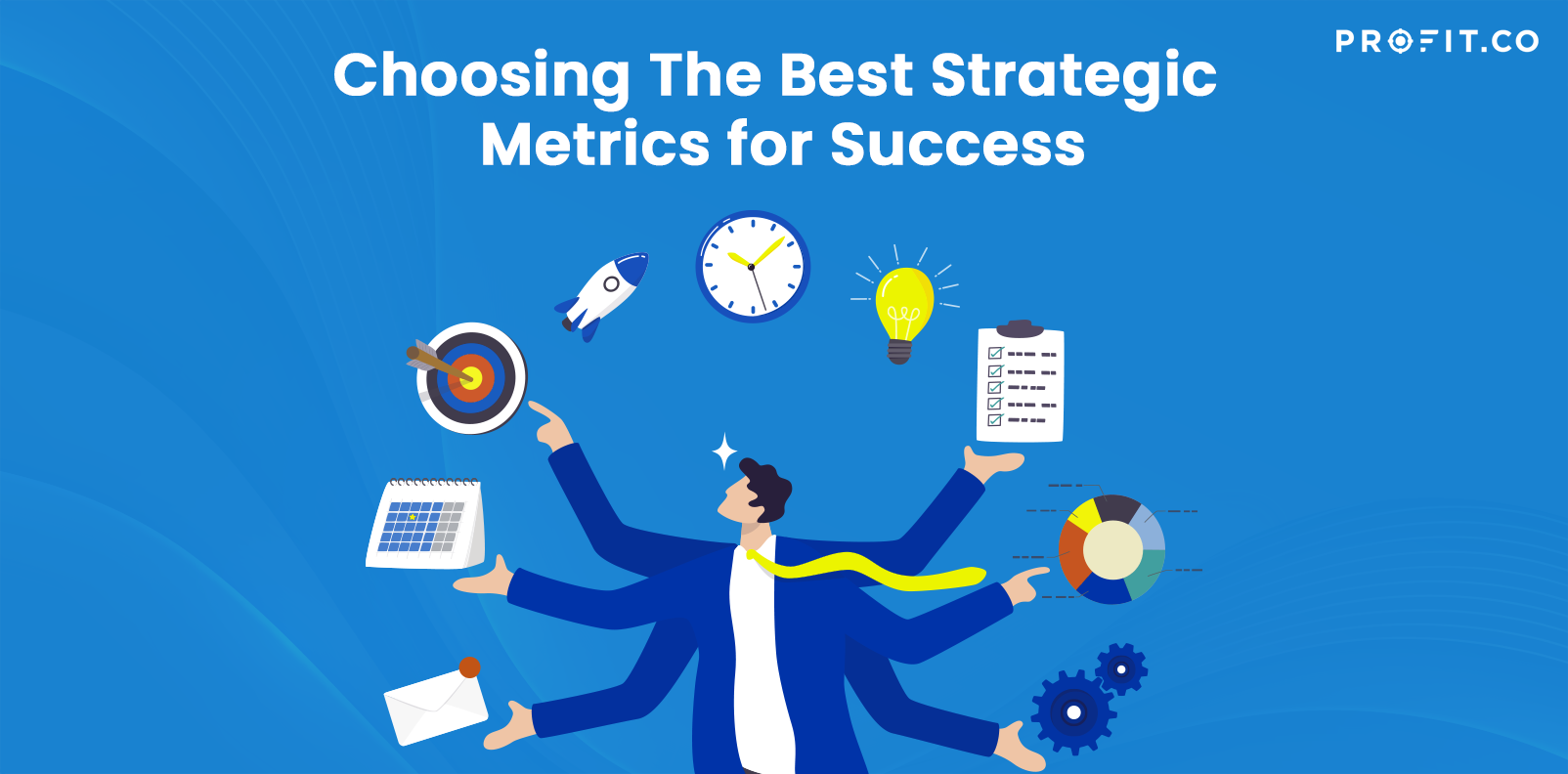You can only achieve objectives by choosing the appropriate metrics to measure and track your progress. Metrics and KPIs are the most effective performance indicators. These measures help monitor your progress toward goals and objectives.
So how can you determine the right strategic metrics for your business? This guide discusses what strategy-based performance metrics are, their qualities, and an easy way to develop performance metrics for your team.
What are Strategy-Based Performance Metrics?
Strategy-based performance metrics are key performance indicators (KPIs) used to measure the progress and success of an organization’s strategic plan. These metrics can help evaluate the plan’s effectiveness and identify improvement areas.
There are two primary types of strategy-based metrics: goal-based strategy monitors and policy-based monitors.
Let’s explore both types of metrics below.
Goal-Based Strategy Monitors
Goal-based strategy monitors are tools that track and measure progress toward strategic goals. Although these monitors appear simple, you’ll need detailed data analysis to identify and specify the relevant business rules to go with the goal monitors. Let’s explore an example of a goal-based strategy monitor.
A potential goal monitor can be to ensure less than 15% customer attrition annually. Tracking and measuring the loss of customers helps you determine customer satisfaction. This information will allow you to track your number of customers and create solutions proactively for customer loss.
Policy-Based Monitors
Policy-based monitors are tools that track and measure compliance with their policies and procedures. These monitors allow organizations to ensure employees follow established policies and procedures and identify areas where policy changes may be needed.
By using policy-based monitors, organizations can ensure that their policies and procedures are adhered to and identify areas where policy changes may be needed to improve compliance and reduce risk.
Policy monitors determine whether you satisfy the actual intention behind your business policy. Loopholes in policy can occur, and customers can take advantage of your business. The reality of the current business scene is that:
- Some will behave accordingly based on your business rules
- Some will discover and attempt to subvert or exploit some business rules
Ready to take your business to the next level with strategic metrics?
If these loopholes link directly to your business rules, the consequences will affect your business.
Let’s look at an example of a policy-based monitor for a business’s order fulfillment capacity. One acceptable business risk can be taking orders above $1,000 on credit without conducting a credit check.
Let’s say that the business policy is that all orders on credit that exceed $1,000 must involve a credit check. There’s a possible subversion pattern where some people can start placing multiple orders for $999 instead of one combined order that exceeds $1,000. The policy monitor can evaluate the defaults between $800 and $999 over the past two months.
Related questions for relevant business rules can be identifying the number of defaults within a certain period and what makes an order default.

What are the Qualities of a Good Strategic Planning Metric?
Implementing the right key performance indicators(KPIs) and metrics requires understanding the crucial aspects of continuous business success. Effective metrics must meet a checklist of standards before becoming applicable and valuable for your team.
Good Strategic Planning Metrics Are:
- Actionable
- Timely
- Quantifiable
- Repeatable
- Understandable
Good strategic planning metrics are actionable. Ensure you choose measures for your team that you can successfully implement. If the metrics you choose have practical value, they will be worthwhile to pursue.
Good strategic planning metrics are timely. Strategic measures require monthly or annual evaluation. Longer durations are harder to align with your strategic plan, so frequent assessments are essential to achieving your goals.
Good strategic planning metrics are quantifiable. Your measures should be objective and tied to statistical facts rather than subjective or based on a gut feeling. Having numbers to measure and compare instead of qualitative metrics provides your team with the most accurate findings.
Good strategic planning metrics are repeatable. Your goal is to monitor progress over time to allow analyzing vital trends, so you need standards you can repeat this sustainably. Repeatable metrics give you ample information to track over periods.
Good strategic planning metrics are understandable. All team members should easily comprehend what you are measuring and be able to track the performance of your measures. Utilizing simple graphs and charts helps achieve clarity for all team members.
If the metrics you are looking at aren’t useful in optimizing your strategy – stop looking at them.
How to Develop Performance Metrics for Strategic Success
Developing performance metrics is essential for your business to succeed.
When creating strategic business performance metrics, be sure to:
- Select a cost-effective measure.
- Measure a particular strategy to evaluate its impact.
- Measure the reason behind your strategy. You need to determine the purpose of the strategic project and whether it serves its purpose.
- Select a metric you can collect monthly data on.
Examples of Strategy-Based Performance Metrics
A variety of businesses can utilize strategy-based performance metrics. Let’s explore some examples of strategy-based metrics different companies use.
Examples of strategy-based metrics:
- Market Share
- Net Promoter Score (NPS)
- Return on Investment (ROI)
- Employee Engagement
- Time to Market
Market share calculates the percentage of the total market that an organization controls. It indicates the effectiveness of the organization’s strategy to capture market share.
NPS measures a customer’s likelihood of recommending an organization to others. This metric is useful in evaluating the effectiveness of the organization’s strategy to create customer loyalty and advocacy.
Return On Investment(ROI) measures an organization’s return on its investment in a particular project or initiative. This metric helps evaluate the effectiveness of the organization’s strategy to allocate resources and make investment decisions.
Employee Engagement measures employee satisfaction and commitment to the organization. It is useful in evaluating the effectiveness of the organization’s strategy to create a positive work environment and culture.
Time to Market measures the time it takes for an organization to bring a product or service to market. It helps evaluate the effectiveness of the organization’s strategy to innovate and stay ahead of the competition.
FAQs
1. What’s the best way to track strategic metrics?
Performance dashboards are the most effective tools for tracking strategic metrics. Dashboards allow periodic reporting while simplifying data through visuals.
2. What are the qualities of a good strategic measure?
A good measure should be repeatable, understandable, quantifiable, timely, and actionable.
3. What are some best practices when selecting measures?
- Have one or more outcome measures for every strategic objective from a financial and customer perspective.
- If you have multiple relevant measures, select the one that best aligns with your objectives’ meaning.
- Avoid having too many measures (over 25) or too few (one or two) for one objective.
Conclusion
New business patterns require customer behavior and strategy evaluation modifications. Your strategic metrics should be able to evolve as new KPIs emerge. Basing these metrics on your business goals enables swift, continuous, and meaningful adaptation.

